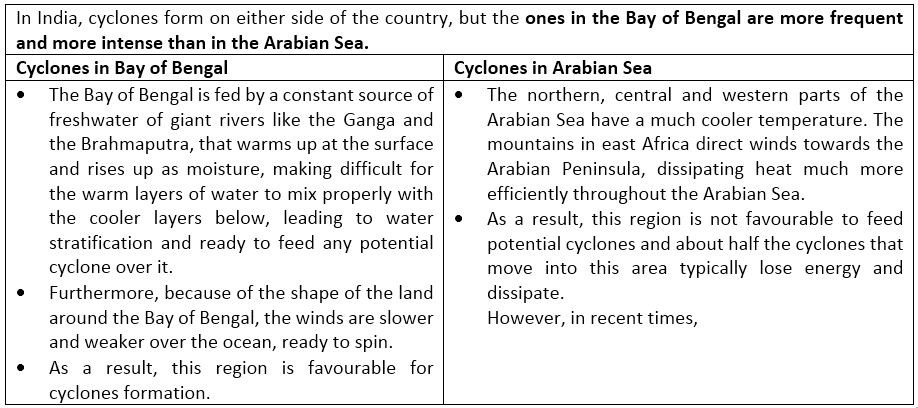26 Jun
Environmental Migrants
In News
Global Report on Internal Displacement 2021 (GRID 2021) was released by the Internal Displacement Monitoring Centre (IDMC). This year's GRID discusses the relationship between climate change, disasters, and displacement.
Background
- Environmental change and disasters have always been major drivers of migration. Climate emergency is the defining crisis of our times and displacement is one of its most devastating consequences.
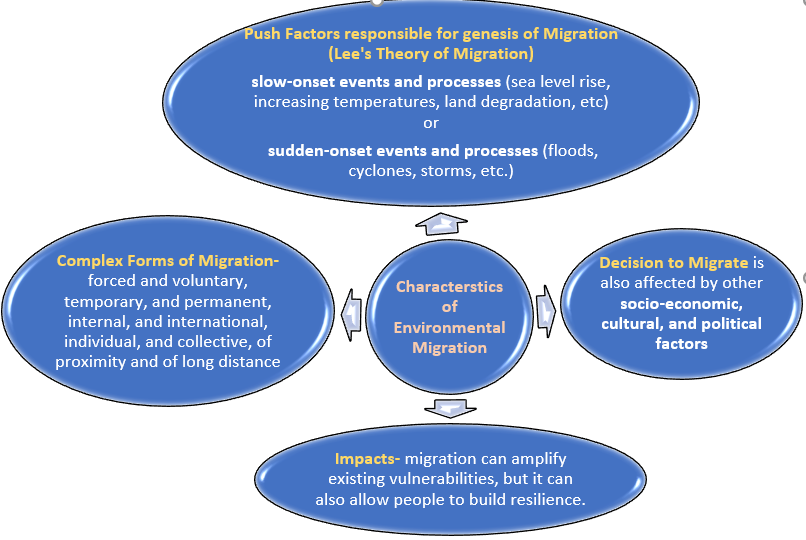
- There is no internationally agreed legal definition for persons on the move due to environmental drivers. However, IOM broadly defines Environmental Migrants as “persons or groups of persons who, predominantly for reasons of sudden or progressive change in the environment, that adversely affects their lives or living conditions, are obliged to leave their habitual homes, or choose to do so, either temporarily or permanently, and who move either within their country or abroad.”
- Refugees, internally displaced people (IDPs) and stateless persons are on the frontlines of the climate emergency. Many are living in climate “hotspots” where they typically lack the resources to adapt to an increasingly inhospitable environment.
- g., in the Sahel region, which is facing one of the fastest growing displacement crises in the world due to conflicts as well as climate change and environmental degradation.
- The 2018 Global Compact for Safe, Orderly and Regular Migration (GCM) recognizes that migration in the context of disasters, climate change, and environmental degradation is a reality, and makes commitments to support both migrants and States.
Recent Trends in Environmental Migration/ Climate induced displacement
- According to GRID 2021, disasters triggered more than three-quarters of the new displacements recorded worldwide in 2020, about 30.7 million. Weather-related events were responsible for 98% of all disaster displacements recorded in 2020.
- The IDMC numbers on disaster displacement show that between 2008 and 2018, disasters caused 265 million new displacements, of which 87% were linked to weather-related hazards.
- In April 2021, the United Nations High Commissioner for Refugees (UNHCR) released data showing that the number of people displaced by climate change-related disasters since 2010 has risen to 21.5 million. For instance, over the past 30 years, the number of people living in coastal areas at high risk of rising sea levels has increased from 160 million to 260 million, 90% of whom are from poor developing countries and small island states.
- The Ecosystem Threat Register (ETR) released in September 2018 by the Institute for Economics and Peace (IEP), an Australian international think tank, points out that at least 1.2 billion people could be displaced by these threats by 2050.
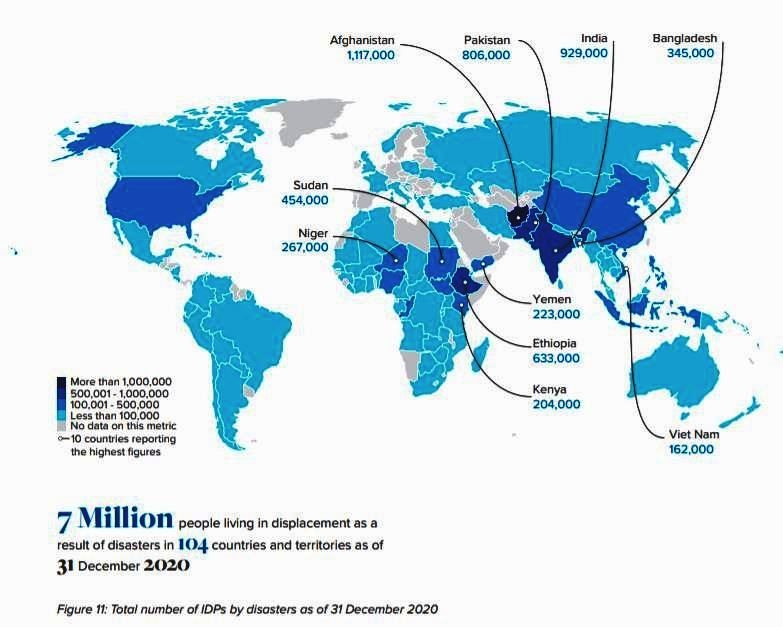
Regional Pattern of Environmental Migration and reasons
- At least seven million people were internally displaced by disasters across 104 countries and territories as of 31 December 2020.
- Most of the new displacements triggered by disasters in 2020 were recorded in East Asia and Pacific and South Asia, as in previous years.
- Intense cyclones, monsoon rains and floods hit highly exposed and densely populated areas in South Asia and East Asia and the Pacific, including China, the Philippines and Bangladesh.
- The Atlantic hurricane season was the most active on record and extended rainy seasons across the Middle East and sub-Saharan Africa uprooted millions more.

Impacts of Disaster induced displacement/ Environmental Migration
- The UN Global Assessment Report 2019 recognizes displacement as one of the stressors for systematic failure, aggravation of vulnerabilities and addition of new risks and other socioeconomic challenges such as inequality, climate change, poverty, under/unemployment and fast-paced urbanization.
- Disaster induced displacements (DID) often lead to stress which in turn is passed on to the new location and its immediate environment by means of human-nature interactions. Such disaster induced mobility has potential to put pressure on shelter, security, service provision, local economy and social relations.
- DID is a kind of forced and involuntary mobility of the affected population whereby in the aftermath of disasters, the socioeconomic and ecological conditions of affected population push them for relocation and outward migration to nearby or far-flung areas providing better opportunities of survival to them. It is not an adaptation strategy but an attempt of survival resulting from lack of other adaptation measures.
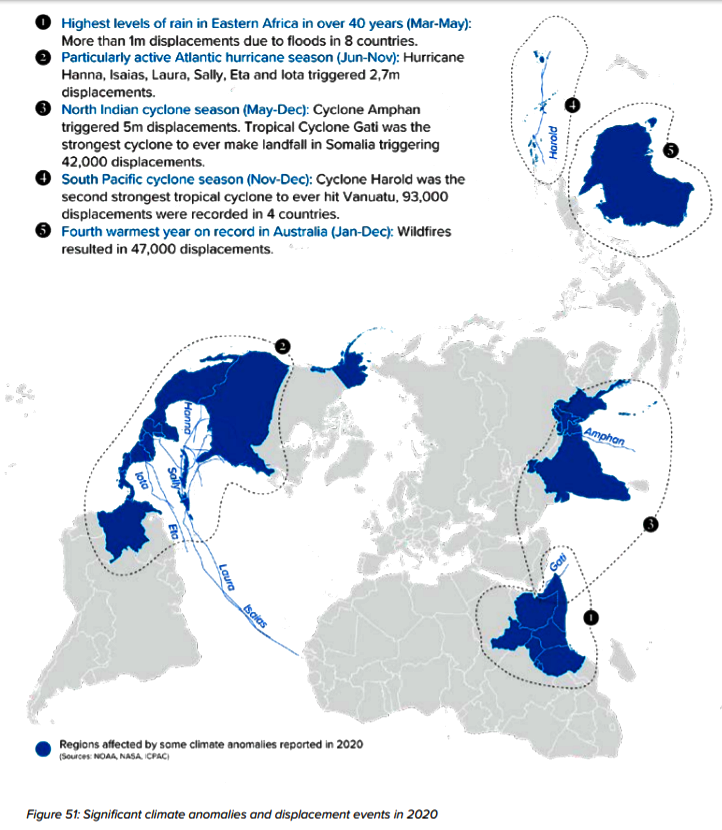

- Cultural background and practices, which are quite specific for a community, especially in a country like India, play an important role. The mixing of two cultural traits due to sudden displacement and the level of acceptance vary from one location to the other. This often leads to conflicts of culture that results into law-and-order issue.
- The inclusion of displaced community is of serious concern, as most of them have lost their physical assets and in many cases identity cards, property documents, etc.
- DID also impacts the state of agriculture due to loss of agricultural labourers who migrate. This has serious consequences for food security and nutritional security of the people.
Way Forward
- As climate change is a reality and its impacts in terms of disasters is visible. So, their legal recognition under international agreements must be adopted. UNHCR must also explore possibilities for granting the environmentally displaced people the status of climatic refugees. This will enable protection of their human rights and a better assistance to restart a new life.
- Also, there is need to prevent the climate change by sticking to Paris Agreement goals. Further, regional and international level cooperation should be made to tackle this challenge. E.g., the EU-funded project to help Pacific Island countries manage the impacts of climate change on migration.
- We can learn from best practices in this regard. Good emergency planning and adaptation policies which mitigate the wet and dry extremes of our changing climate will reduce these pressures on migration.

- Although the SDGs do not explicitly link climate change and migration, SDG target 10.7 calls for signatories to “facilitate orderly, safe, and responsible migration of people, including through implementation of planned and well-managed policies.”
Where can we use it?
Paper1 – Climatology (climate change), Environment Geography (Environment hazards, management and policies, remedial measures, legislation), Population Geography (Migration), Regional Planning.
Paper2 -Cultural Setting (Migration), Contemporary Issues.
Sources:
- 1) Internal displacement in a changing climate
- 2) Climate refugees – the world’s forgotten victims
- 3) How climate change exacerbates the refugee crisis – and what can be done about it
- 4) Is the global refugee crisis linked to climate change?
- 5) Migration in response to environmental change
- 6) Data reveals impacts of climate emergency on displacement
- 7) Climate change link to displacement of most vulnerable is clear: UNHCR
- 8) Climate change and disaster displacement
- 9) The climate crisis, migration, and refugees
- 10) 5 facts on climate migrants
- 11) Let’s Talk About Climate Migrants, Not Climate Refugees
- 12) Migration out of climate change
- 13) Climate change and migration in vulnerable countries
- 14) Assessing the climate change, environmental degradation and migration nexus in South Asia
- 15) Environmental Refugee
- 16) Climate Refugees
- 17) Environmental Migration
- 18) Hot, wet, and deserted: Climate Change and Internal Displacement in India, Peru, and Tanzania
- 19) Climate-Induced Displacement: South Asia’s Clear and Present Danger
Environmental Migrants
In News
Global Report on Internal Displacement 2021 (GRID 2021) was released by the Internal Displacement Monitoring Centre (IDMC). This year's GRID discusses the relationship between climate change, disasters, and displacement.
Background
- Environmental change and disasters have always been major drivers of migration. Climate emergency is the defining crisis of our times and displacement is one of its most devastating consequences.
- There is no internationally agreed legal definition for persons on the move due to environmental drivers. However, IOM broadly defines Environmental Migrants as “persons or groups of persons who, predominantly for reasons of sudden or progressive change in the environment, that adversely affects their lives or living conditions, are obliged to leave their habitual homes, or choose to do so, either temporarily or permanently, and who move either within their country or abroad.”
- Refugees, internally displaced people (IDPs) and stateless persons are on the frontlines of the climate emergency. Many are living in climate “hotspots” where they typically lack the resources to adapt to an increasingly inhospitable environment.
- g., in the Sahel region, which is facing one of the fastest growing displacement crises in the world due to conflicts as well as climate change and environmental degradation.
- The 2018 Global Compact for Safe, Orderly and Regular Migration (GCM) recognizes that migration in the context of disasters, climate change, and environmental degradation is a reality, and makes commitments to support both migrants and States.
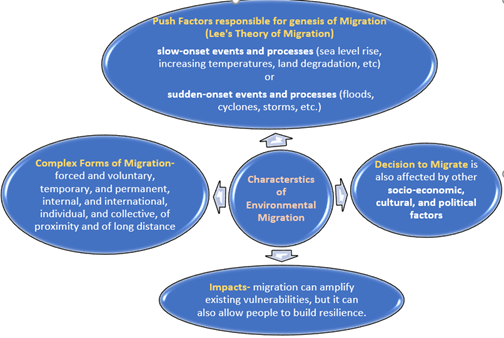
Recent Trends in Environmental Migration/ Climate induced displacement
- According to GRID 2021, disasters triggered more than three-quarters of the new displacements recorded worldwide in 2020, about 30.7 million. Weather-related events were responsible for 98% of all disaster displacements recorded in 2020.
- The IDMC numbers on disaster displacement show that between 2008 and 2018, disasters caused 265 million new displacements, of which 87% were linked to weather-related hazards.
- In April 2021, the United Nations High Commissioner for Refugees (UNHCR) released data showing that the number of people displaced by climate change-related disasters since 2010 has risen to 21.5 million. For instance, over the past 30 years, the number of people living in coastal areas at high risk of rising sea levels has increased from 160 million to 260 million, 90% of whom are from poor developing countries and small island states.
- The Ecosystem Threat Register (ETR) released in September 2018 by the Institute for Economics and Peace (IEP), an Australian international think tank, points out that at least 1.2 billion people could be displaced by these threats by 2050.
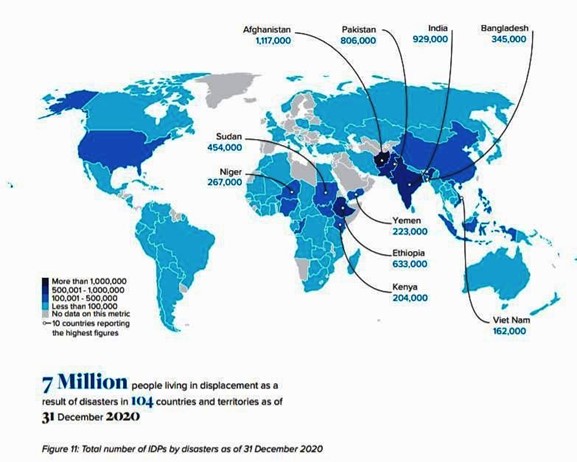
Regional Pattern of Environmental Migration and reasons
- At least seven million people were internally displaced by disasters across 104 countries and territories as of 31 December 2020.
- Most of the new displacements triggered by disasters in 2020 were recorded in East Asia and Pacific and South Asia, as in previous years.
- Intense cyclones, monsoon rains and floods hit highly exposed and densely populated areas in South Asia and East Asia and the Pacific, including China, the Philippines and Bangladesh.
- The Atlantic hurricane season was the most active on record and extended rainy seasons across the Middle East and sub-Saharan Africa uprooted millions more.

- The UN Global Assessment Report 2019 recognizes displacement as one of the stressors for systematic failure, aggravation of vulnerabilities and addition of new risks and other socioeconomic challenges such as inequality, climate change, poverty, under/unemployment and fast-paced urbanization.Impacts of Disaster induced displacement/ Environmental Migration
- Disaster induced displacements (DID) often lead to stress which in turn is passed on to the new location and its immediate environment by means of human-nature interactions. Such disaster induced mobility has potential to put pressure on shelter, security, service provision, local economy and social relations.
- DID is a kind of forced and involuntary mobility of the affected population whereby in the aftermath of disasters, the socioeconomic and ecological conditions of affected population push them for relocation and outward migration to nearby or far-flung areas providing better opportunities of survival to them. It is not an adaptation strategy but an attempt of survival resulting from lack of other adaptation measures.


- Cultural background and practices, which are quite specific for a community, especially in a country like India, play an important role. The mixing of two cultural traits due to sudden displacement and the level of acceptance vary from one location to the other. This often leads to conflicts of culture that results into law-and-order issue.
- The inclusion of displaced community is of serious concern, as most of them have lost their physical assets and in many cases identity cards, property documents, etc.
- DID also impacts the state of agriculture due to loss of agricultural labourers who migrate. This has serious consequences for food security and nutritional security of the people.
Way Forward
- As climate change is a reality and its impacts in terms of disasters is visible. So, their legal recognition under international agreements must be adopted. UNHCR must also explore possibilities for granting the environmentally displaced people the status of climatic refugees. This will enable protection of their human rights and a better assistance to restart a new life.
- Also, there is need to prevent the climate change by sticking to Paris Agreement goals. Further, regional and international level cooperation should be made to tackle this challenge. E.g., the EU-funded project to help Pacific Island countries manage the impacts of climate change on migration.
- We can learn from best practices in this regard. Good emergency planning and adaptation policies which mitigate the wet and dry extremes of our changing climate will reduce these pressures on migration.

- Although the SDGs do not explicitly link climate change and migration, SDG target 10.7 calls for signatories to “facilitate orderly, safe, and responsible migration of people, including through implementation of planned and well-managed policies.”
Where can we use it :
Paper1 – Climatology (climate change), Environment Geography (Environment hazards, management and policies, remedial measures, legislation), Population Geography (Migration), Regional Planning.
Paper2 -Cultural Setting (Migration), Contemporary Issues.
Environmental Migrants
In News
Global Report on Internal Displacement 2021 (GRID 2021) was released by the Internal Displacement Monitoring Centre (IDMC). This year's GRID discusses the relationship between climate change, disasters, and displacement.
Background
- Environmental change and disasters have always been major drivers of migration. Climate emergency is the defining crisis of our times and displacement is one of its most devastating consequences.
- There is no internationally agreed legal definition for persons on the move due to environmental drivers. However, IOM broadly defines Environmental Migrants as “persons or groups of persons who, predominantly for reasons of sudden or progressive change in the environment, that adversely affects their lives or living conditions, are obliged to leave their habitual homes, or choose to do so, either temporarily or permanently, and who move either within their country or abroad.”
- Refugees, internally displaced people (IDPs) and stateless persons are on the frontlines of the climate emergency. Many are living in climate “hotspots” where they typically lack the resources to adapt to an increasingly inhospitable environment.
- g., in the Sahel region, which is facing one of the fastest growing displacement crises in the world due to conflicts as well as climate change and environmental degradation.
- The 2018 Global Compact for Safe, Orderly and Regular Migration (GCM) recognizes that migration in the context of disasters, climate change, and environmental degradation is a reality, and makes commitments to support both migrants and States.
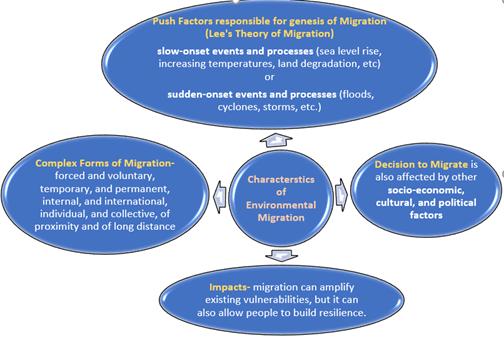
Recent Trends in Environmental Migration/ Climate induced displacement
- According to GRID 2021, disasters triggered more than three-quarters of the new displacements recorded worldwide in 2020, about 30.7 million. Weather-related events were responsible for 98% of all disaster displacements recorded in 2020.
- The IDMC numbers on disaster displacement show that between 2008 and 2018, disasters caused 265 million new displacements, of which 87% were linked to weather-related hazards.
- In April 2021, the United Nations High Commissioner for Refugees (UNHCR) released data showing that the number of people displaced by climate change-related disasters since 2010 has risen to 21.5 million. For instance, over the past 30 years, the number of people living in coastal areas at high risk of rising sea levels has increased from 160 million to 260 million, 90% of whom are from poor developing countries and small island states.
- The Ecosystem Threat Register (ETR) released in September 2018 by the Institute for Economics and Peace (IEP), an Australian international think tank, points out that at least 1.2 billion people could be displaced by these threats by 2050.

Regional Pattern of Environmental Migration and reasons
- At least seven million people were internally displaced by disasters across 104 countries and territories as of 31 December 2020.
- Most of the new displacements triggered by disasters in 2020 were recorded in East Asia and Pacific and South Asia, as in previous years.
- Intense cyclones, monsoon rains and floods hit highly exposed and densely populated areas in South Asia and East Asia and the Pacific, including China, the Philippines and Bangladesh.
- The Atlantic hurricane season was the most active on record and extended rainy seasons across the Middle East and sub-Saharan Africa uprooted millions more.
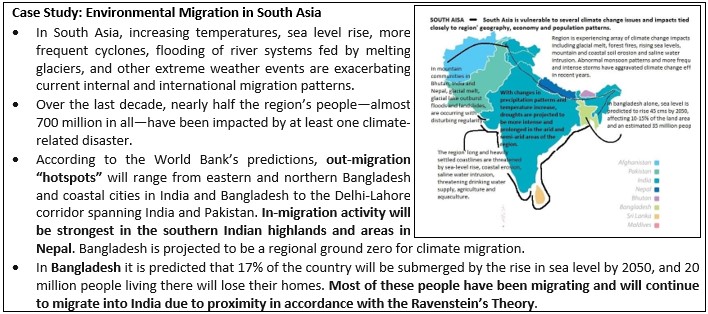
The UN Global Assessment Report 2019 recognizes displacement as one of the stressors for systematic failure, aggravation of vulnerabilities and addition of new risks and other socioeconomic challenges such as inequality, climate change, poverty, under/unemployment and fast-paced urbanization.Impacts of Disaster induced displacement/ Environmental Migration
- Disaster induced displacements (DID) often lead to stress which in turn is passed on to the new location and its immediate environment by means of human-nature interactions. Such disaster induced mobility has potential to put pressure on shelter, security, service provision, local economy and social relations.
- DID is a kind of forced and involuntary mobility of the affected population whereby in the aftermath of disasters, the socioeconomic and ecological conditions of affected population push them for relocation and outward migration to nearby or far-flung areas providing better opportunities of survival to them. It is not an adaptation strategy but an attempt of survival resulting from lack of other adaptation measures.
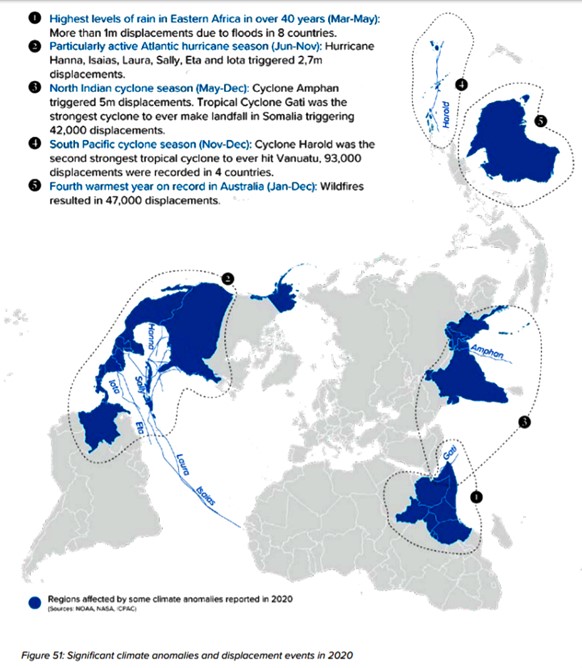

- Cultural background and practices, which are quite specific for a community, especially in a country like India, play an important role. The mixing of two cultural traits due to sudden displacement and the level of acceptance vary from one location to the other. This often leads to conflicts of culture that results into law-and-order issue.
- The inclusion of displaced community is of serious concern, as most of them have lost their physical assets and in many cases identity cards, property documents, etc.
- DID also impacts the state of agriculture due to loss of agricultural labourers who migrate. This has serious consequences for food security and nutritional security of the people.
Way Forward
- As climate change is a reality and its impacts in terms of disasters is visible. So, their legal recognition under international agreements must be adopted. UNHCR must also explore possibilities for granting the environmentally displaced people the status of climatic refugees. This will enable protection of their human rights and a better assistance to restart a new life.
- Also, there is need to prevent the climate change by sticking to Paris Agreement goals. Further, regional and international level cooperation should be made to tackle this challenge. E.g., the EU-funded project to help Pacific Island countries manage the impacts of climate change on migration.
- We can learn from best practices in this regard. Good emergency planning and adaptation policies which mitigate the wet and dry extremes of our changing climate will reduce these pressures on migration.

- Although the SDGs do not explicitly link climate change and migration, SDG target 10.7 calls for signatories to “facilitate orderly, safe, and responsible migration of people, including through implementation of planned and well-managed policies.”
Where can we use it :
Paper1 – Climatology (climate change), Environment Geography (Environment hazards, management and policies, remedial measures, legislation), Population Geography (Migration), Regional Planning.
Paper2 -Cultural Setting (Migration), Contemporary Issues.
Why MPD 2041? - Strategy for Urban development in rapidly Urbanizing India
- Why in news: The Delhi DevelopmentAuthority (DDA) has approved the draft Master Plan 2041 (MPD 2041- Post 2021 plan).
- Background: Aim preparing and implementing a master plan is to ensure the proper use of land, protect the environment, and preserve the people’s cultures and traditions and take city progress through multitude of realms, i.e. social, physical, economic, and environmental.
- Challenges in Urban areas of India: The combination of a huge population, strong inter-regional linkages, and planning and governance deficits results in numerous problem such as:

- How Master Plan for Delhi can solve the Urban challenges:
-
- Area-based improvement approach will be adopted for revitalizing the commercial and socio-cultural hubs and to encourage greater public participation.
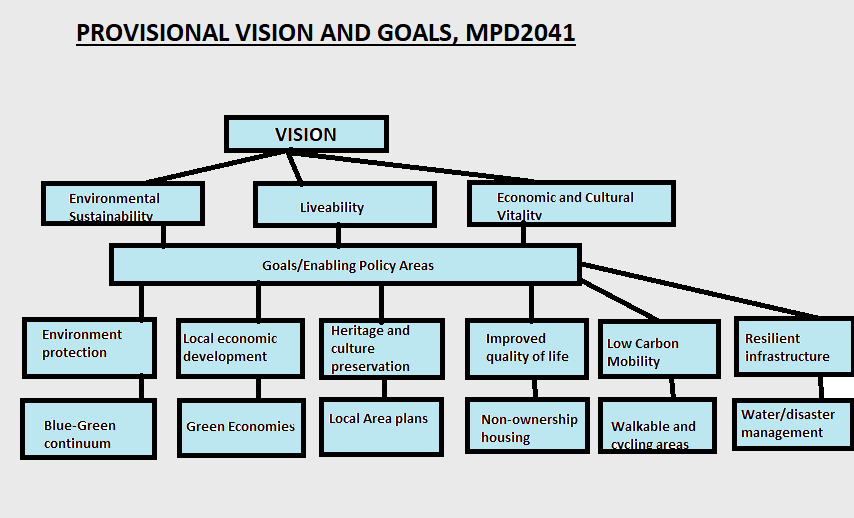
-
- Localized economic development which may become potential “Growth Pole”- Identifying strategic hubs and corridors, establishing clean and green economy (green produce, recycling of products) and supporting unorganized sector (design of vending zones).
- Preservation of heritage and culture- By preparing local area plans, ensuring safety in public areas, and promoting nightlife, the master plan focuses on cultural festivals
- For better quality of life (QoL) and development of “Social Capital”-
- Non-ownership housing will be supported and mixed use of buildings will be encouraged and social infrastructure provision will be facilitated, considering the large migrant population.
- Development of counter urbanization centers like counter-magnet cities, charter cities, satellite towns, smart villages etc.
Example : Gurgaon for Delhi.
-
- Low carbon mobility and to tackle traffic congestion-
- Plan proposes creating walk-able and cycling areas, transit-oriented development(TOD), mobility corridors (for freight movement, bypasses), shifting from private to public transport, rationalizing parking, promoting the use of low-carbon technologies (e.g. electric vehicles), the principle of ‘user pays’ etc.
- Recommends corridors that will act as “road links”, or extensions of existing or proposed arterial corridors to improve inter-city connectivity.
- Environmentalism approach for environment sustainability and tackling pollution:
- Minimize vehicular pollution by adopting of mix-use transit-oriented development (TOD), migration to greener fuels for public transport.
- Water quality improvement.
- Focus on strategic components of sustainable city management: pan city development via green-blue corridors and development in green belt villages while preserving eco-cultural assets.
- Spatial-planning strategies like catalyzing urban regeneration (brown-field improvement), and smart and sustainable development of new areas (green-field development).
- On energy diversification and Development of energy-efficient cities: “Renewable Energy Plan” to identify potential energy generation areas within the city along with strategies to meet the targets outlined by the Union ministry of new and renewable energy.
- Example : MPD has asked the government to expedite its agriculture-cum-solar farm scheme by incentivizing landowners to set up solar farms on their agricultural lands.
- Development of Resilient infrastructure- through integrated water management, decentralized waste management, the setting up of digital infrastructure, and facilities for disaster management. SDG11 aims towards sustainable cities and communities.
- Low carbon mobility and to tackle traffic congestion-
- India'surban population is expected to grow to 814 million by 2050 and is projected to add 4 new megacities by 2030, Thus Urban Planning on lines of MPD2041 is need of the hour in future as well as existing urban centers like Mumbai, Kolkata, Bangalore, Chennai, Hyderabad etc.
- Where can we use it:
- Paper1- Settlement (urbanization), Regional planning (Growth centers\pole, Regional imbalances, Sustainable development).
- paper2 -Settlement (urbanization), Regional development and Regional Planning.
References:
- 1) Green economy and mobility key aspects of draft 2041 master plan
- 2) Draft of Delhi Master Plan 2041 focuses on tackling pollution and urban development
- 3) Delhi Master Plan 2021–41: Towards a People’s City?
- 4) What is Delhi Master Plan 2041? Know about its main focus areas, challenges & other details
- 5) Draft Master Plan recommends annual ‘Renewable Energy Plan’ in Delhi
- 6) Drop in private vehicle use, better last-mile transit in vision document
Deep Ocean Mission- Potential for India
- Why in news: The Union Cabinet has approved Deep Ocean Mission
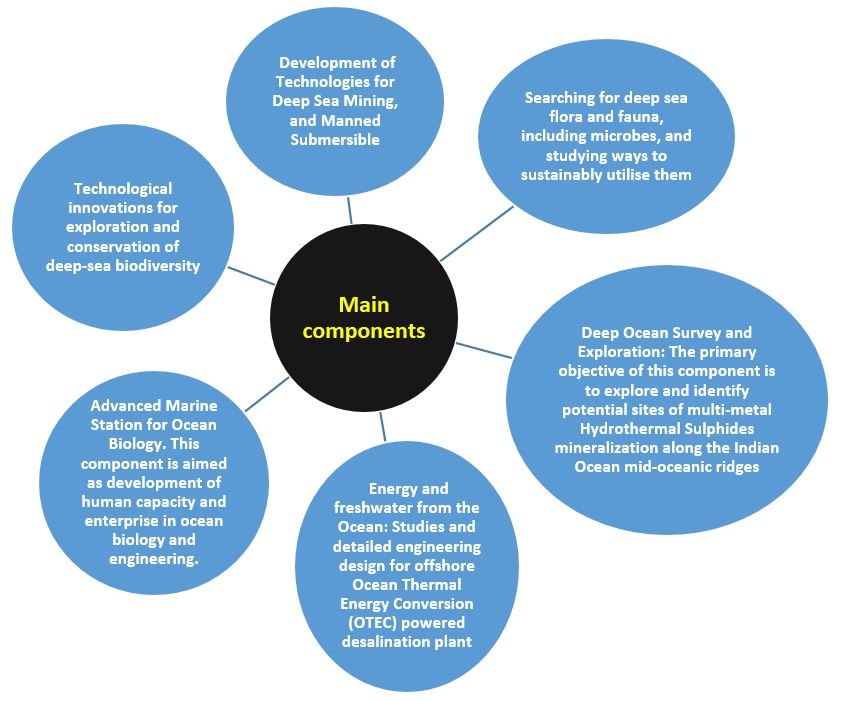
- Background: Mission involves developing a submersible vehicle that will allow a crew to plunge 6,000 meters into the ocean and hunt the floor for precious metals. Ministry of Earth Sciences (MoES) will act as nodal Ministry implementing this multi-institutional mission.
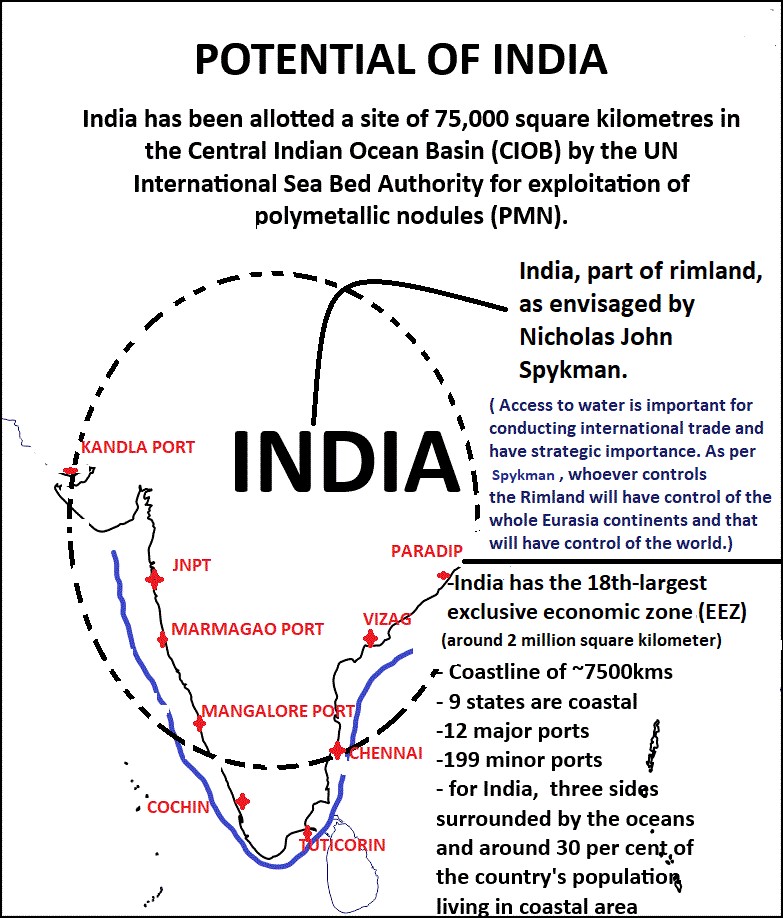
- Potential of Deep Ocean Mission for India:
- Geopolitical Advantage:
- Will make India one among the Strategically important nations that already have dedicated ocean studies and missions, including the US, Japan, France, Russia and China.
- Can add to Indian strategy of countering china’ assertiveness in Indian Ocean Region through it String of Pearls.
- Economic and developmental advantages:
- The exploration studies of minerals will pave way for the commercial exploitation of resources like PMN, rare earth etc in the near future.
- Would enable India to develop capabilities to exploit marine resources and minerals like cobalt, zinc, manganese, and rare earth metals for electronic industries, giving fillip to Make in India and fulfill objectives of Atmanirbhar Bharat.
- The design, development and fabrication of specialized equipment, ships and set-up of required infrastructure and capacity development in Marine Biology is expected to bring employment opportunities for MSMEs and start-ups.
- Contribute to regional development of Coastal areas by connecting it to mainland India through functional linkages- help fulfill vision of SAGARMALA e. Port Modernization, Port Connectivity Enhancement, Port-linked Industrialization, Coastal Community Development and development of Coastal Shipping & Inland Waterways Transport.
- Way to energy security:
- According to MoES, even a fraction of that reserve can meet the energy requirement of India for the next 100 years.
- Support to “Blue Economy” and environmental sustainability:
- As highlighted by ‘Draft Blue Economy Policy’, Deep Ocean Mission, through sustainable and innovative development, will help to achieve holistic growth of Indian Economy.
- Components like Technological innovation, Marine station for ocean biology, Development of Ocean Climate Change Advisory Services etc will support the Blue Economy priority area of Marine Biology, Marine Fisheries and allied services, Blue trade, sustainable tourism and Blue manufacturing etc.
- Potential to research and development on conservation of Biodiversity and fragile ecosystem like coral in Lakshadweep.
- Challenges:
- Technologies required for deep sea mining have strategic implications and are not commercially available. Therefore attempt should be made to indigenize technologies by collaborating with leading institutes and private industries.
- Establishment of single agency for co-ordination and integrated and coordinated approach to avoid overlap and duplication.
- Would have adverse impact on marine ecosystem- might cause irreplaceable damage to un-touched flora and fauna of deep seas.
- Oceans are also storehouse of food, energy, minerals, medicines, modulator of weather and climate and underpin life on Earth. Considering importance of the oceans on sustainability, the United Nations (UN) has declared the decade, 2021-2030 as the Decade of Ocean Science for Sustainable Development of marine ecology (SDG-14).
- Where can we use it :
- Paper1: Oceanography(marine resources), Environment Geography( Ecosystem and sustainable development), Economic Geography( Energy security, Food security, world resource distribution etc).
- Paper2: Resources, Political aspect (geopolitics of Indian Ocean Realm), Contemporary issues
- Paper I (GS): Distribution of key natural resources across the world.
- Paper III (GS): .Mobilization of resources, Environment, Conservation.
Tags: UPSC, Geography, Optional, Deep ocean mission, Energy security, Oceanography, Ocean resources.
References:
Why MPD 2041? - Strategy for Urban development in rapidly Urbanizing India
- Why in news: The Delhi DevelopmentAuthority (DDA) has approved the draft Master Plan 2041 (MPD 2041- Post 2021 plan).
- Background: Aim preparing and implementing a master plan is to ensure the proper use of land, protect the environment, and preserve the people’s cultures and traditions and take city progress through multitude of realms, i.e. social, physical, economic, and environmental.
- Challenges in Urban areas of India: The combination of a huge population, strong inter-regional linkages, and planning and governance deficits results in numerous problem such as:
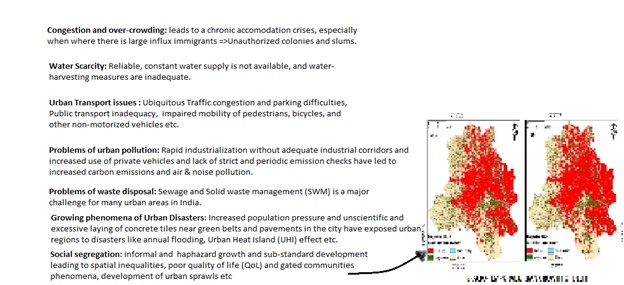
- How Master Plan for Delhi can solve the Urban challenges:
- Area-based improvement approach will be adopted for revitalizing the commercial and socio-cultural hubs and to encourage greater public participation.

-
- Localized economic development which may become potential “Growth Pole”- Identifying strategic hubs and corridors, establishing clean and green economy (green produce, recycling of products) and supporting unorganized sector (design of vending zones).
- Preservation of heritage and culture- By preparing local area plans, ensuring safety in public areas, and promoting nightlife, the master plan focuses on cultural festivals
- For better quality of life (QoL) and development of “Social Capital”-
- Non-ownership housing will be supported and mixed use of buildings will be encouraged and social infrastructure provision will be facilitated, considering the large migrant population.
- Development of counter urbanization centers like counter-magnet cities, charter cities, satellite towns, smart villages etc. Example : Gurgaon for Delhi.
-
- Low carbon mobility and to tackle traffic congestion-
- Plan proposes creating walk-able and cycling areas, transit-oriented development(TOD), mobility corridors (for freight movement, bypasses), shifting from private to public transport, rationalizing parking, promoting the use of low-carbon technologies (e.g. electric vehicles), the principle of ‘user pays’ etc.
- Recommends corridors that will act as “road links”, or extensions of existing or proposed arterial corridors to improve inter-city connectivity.
- Environmentalism approach for environment sustainability and tackling pollution:
- Minimize vehicular pollution by adopting of mix-use transit-oriented development (TOD), migration to greener fuels for public transport.
- Water quality improvement.
- Focus on strategic components of sustainable city management: pan city development via green-blue corridors and development in green belt villages while preserving eco-cultural assets.
- Spatial-planning strategies like catalyzing urban regeneration (brown-field improvement), and smart and sustainable development of new areas (green-field development).
- On energy diversification and Development of energy-efficient cities: “Renewable Energy Plan” to identify potential energy generation areas within the city along with strategies to meet the targets outlined by the Union ministry of new and renewable energy.
- Example : MPD has asked the government to expedite its agriculture-cum-solar farm scheme by incentivizing landowners to set up solar farms on their agricultural lands.
- Development of Resilient infrastructure- through integrated water management, decentralized waste management, the setting up of digital infrastructure, and facilities for disaster management. SDG11 aims towards sustainable cities and communities.
- Low carbon mobility and to tackle traffic congestion-
- India'surban population is expected to grow to 814 million by 2050 and is projected to add 4 new megacities by 2030, Thus Urban Planning on lines of MPD2041 is need of the hour in future as well as existing urban centers like Mumbai, Kolkata, Bangalore, Chennai, Hyderabad etc.
- Where can we use it:
- Paper1- Settlement (urbanization), Regional planning (Growth centers\pole, Regional imbalances, Sustainable development).
- Paper2 -Settlement (urbanization), Regional development and Regional Planning.
Deep Ocean Mission- Potential for India
- Why in news: The Union Cabinet has approved Deep Ocean Mission

- Background: Mission involves developing a submersible vehicle that will allow a crew to plunge 6,000 meters into the ocean and hunt the floor for precious metals. Ministry of Earth Sciences (MoES) will act as nodal Ministry implementing this multi-institutional mission.
- Potential of Deep Ocean Mission for India:
- Geopolitical Advantage:
- Will make India one among the Strategically important nations that already have dedicated ocean studies and missions, including the US, Japan, France, Russia and China.
- Can add to Indian strategy of countering china’ assertiveness in Indian Ocean Region through it String of Pearls.
- Economic and developmental advantages:
- The exploration studies of minerals will pave way for the commercial exploitation of resources like PMN, rare earth etc in the near future.
- Would enable India to develop capabilities to exploit marine resources and minerals like cobalt, zinc, manganese, and rare earth metals for electronic industries, giving fillip to Make in India and fulfill objectives of Atmanirbhar Bharat.
- The design, development and fabrication of specialized equipment, ships and set-up of required infrastructure and capacity development in Marine Biology is expected to bring employment opportunities for MSMEs and start-ups.
- Contribute to regional development of Coastal areas by connecting it to mainland India through functional linkages- help fulfill vision of SAGARMALA e. Port Modernization, Port Connectivity Enhancement, Port-linked Industrialization, Coastal Community Development and development of Coastal Shipping & Inland Waterways Transport.
- Geopolitical Advantage:
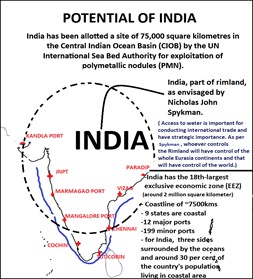
-
- Way to energy security:
- According to MoES, even a fraction of that reserve can meet the energy requirement of India for the next 100 years.
- Support to “Blue Economy” and environmental sustainability:
- As highlighted by ‘Draft Blue Economy Policy’, Deep Ocean Mission, through sustainable and innovative development, will help to achieve holistic growth of Indian Economy.
- Components like Technological innovation, Marine station for ocean biology, Development of Ocean Climate Change Advisory Services etc will support the Blue Economy priority area of Marine Biology, Marine Fisheries and allied services, Blue trade, sustainable tourism and Blue manufacturing etc.
- Potential to research and development on conservation of Biodiversity and fragile ecosystem like coral in Lakshadweep.
- Way to energy security:
- Challenges:
- Technologies required for deep sea mining have strategic implications and are not commercially available. Therefore attempt should be made to indigenize technologies by collaborating with leading institutes and private industries.
- Establishment of single agency for co-ordination and integrated and coordinated approach to avoid overlap and duplication.
- Would have adverse impact on marine ecosystem- might cause irreplaceable damage to un-touched flora and fauna of deep seas.
- Oceans are also storehouse of food, energy, minerals, medicines, modulator of weather and climate and underpin life on Earth. Considering importance of the oceans on sustainability, the United Nations (UN) has declared the decade, 2021-2030 as the Decade of Ocean Science for Sustainable Development of marine ecology (SDG-14).
- Where can we use it :
- Paper1: Oceanography(marine resources), Environment Geography( Ecosystem and sustainable development), Economic Geography( Energy security, Food security, world resource distribution etc).
- Paper2: Resources, Political aspect (geopolitics of Indian Ocean Realm), Contemporary issues
- Paper I (GS): Distribution of key natural resources across the world.
- Paper III (GS): .Mobilization of resources, Environment, Conservation.
Pyrocumulus Cloud
A pyrocumulus cloud which is officially known as flammagenitus, forms from rising air that results from intense heating of the surface by phenomena such as wildfires or volcanic eruptions. In Latin, pyro means “fire” and cumulus means “pile up.” Cumulus is a type of cloud that is common in Wisconsin, particularly in summer.
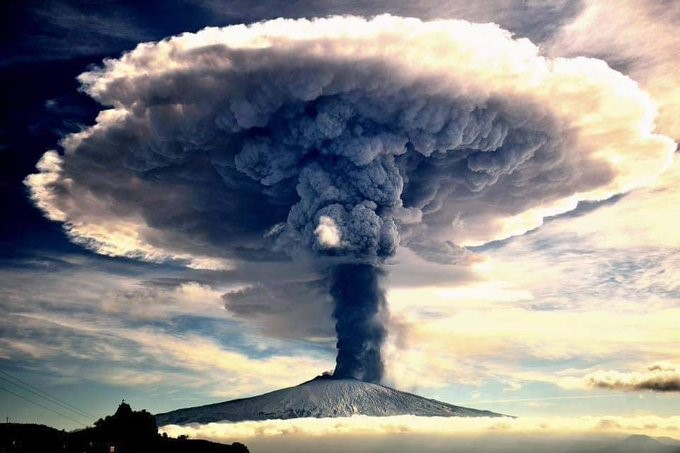
A big fire produces strong upward moving air currents that carry water vapour and ash upward. The water vapour can condense on the ash forming cloud drops. The vigorous upward motions produce these pyrocumulus clouds that look similar to thunderstorm clouds, which also form due to strong upward moving air. Cumulus clouds are those puffy-white clouds with tops that have a cauliflower appearance. Pyrocumulus clouds are greyish or brown in colour because of the ashes and smoke of the fire. The tops of these clouds can reach as high as 30,000 feet.
Instance: A pyrocumulonimbus cloud rose up over the Orroral Valley bushfire burning to the south of Canberra, Australia, on January 31, 2020.
Sources:
Bergschrund
The Bergschrund or “Schrund Line” is a term that refers to the crevasse which develops at the head of mountain or corrie glaciers immediately adjacent to the rock wall of the mountain itself. As the glacier ice gradually moves down and away from the wall, a massive plucking or sapping operation takes place, whereby the rock of the mountain is progressively torn away from the mountain wall and eventually transported by ice movement or melt-water to the moraine area. Lewis has stressed both the roles of meltwater and pressure release in the bergschrund.
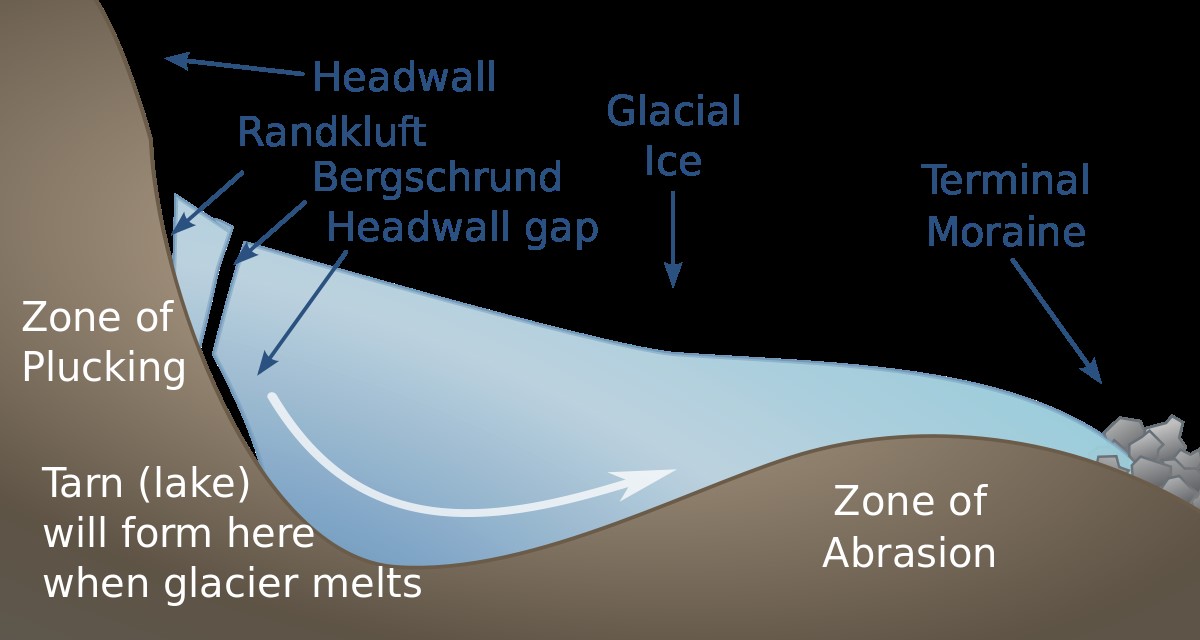
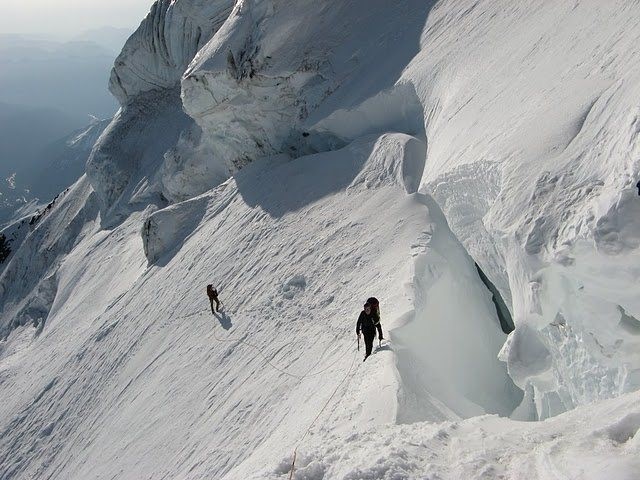
A rock and ice avalanche caused the devastation in and around Chamoli district in Uttarakhand in February,2021 which was due to a crack near the bergschrund.
Sources:
Environmentalism
According to O’Riordan, “environmentalism is a collage of values and views of the world, a general pattern of predisposition, being first and foremost social movement, based on philosophy that embraces Earth- centeredness”.
There are 2 perspectives on environmentalism. The 1st is conservative view of society – nature relationship, where nature provides a metaphor for morality & a guide to rules of conduct. The 2nd perspective is radical, in which the spirit of competition in skill dictates the terms of ethics & conduct.
The recent perception of environmentalism is focused on belief that human well- being is possible only if nature is accorded its right-full place as a friendly partner in the process of development and growth and built upon deep faith that survival of humankind is dependent on the survival of a healthy and ecologically balanced environment. It attempts a greater sensitivity and awareness about the “environment” and is very close to current concept of sustainable development.
Social Capital
- Social capital is defined by the OECD as “networks together with shared norms, values and understandings that facilitate co-operation within or among groups”.
- Varieties of social capital
- There’s much debate over the various forms that social capital takes, but one fairly straightforward approach divides it into three main categories:-
- Bonds: Links to people based on a sense of common identity (“people like us”) – such as family, close friends and people who share our culture or ethnicity.
- Bridges: Links that stretch beyond a shared sense of identity, for example to distant friends, colleagues and associates.
- Linkages: Links to people or groups further up or lower down the social ladder
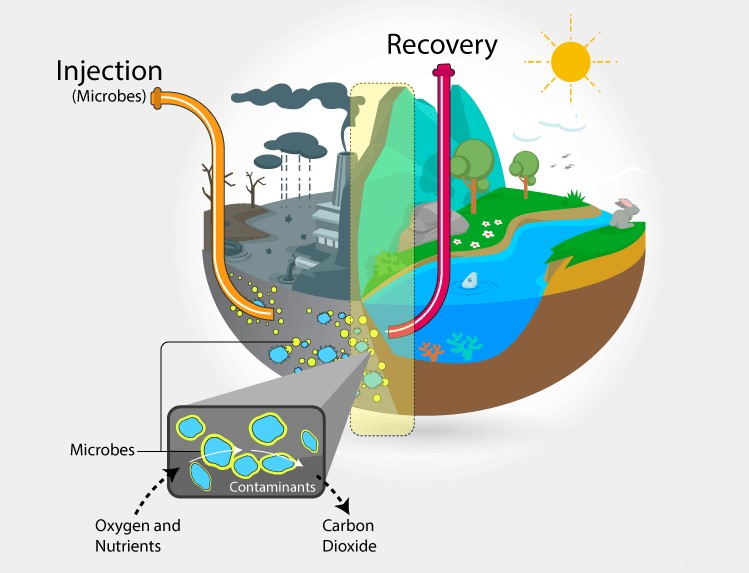
- Social capital provides the glue which facilitates co-operation, exchange and innovation.”
- Human capital and social capital don’t exist in isolation from each other.
The two are linked in complex ways but at some extent, feed into each other. In other words social capital promotes the development of human capital and vice-versa, although the mechanics of the process are complex.
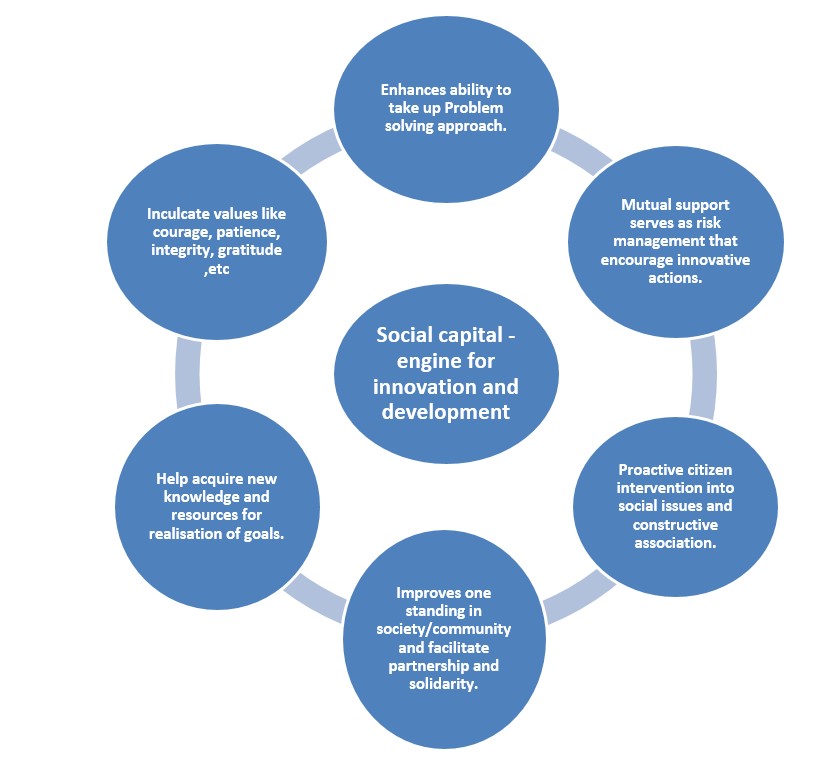
Bioremediation
- Bioremediation is the use of living microorganisms (bacteria or fungi or plants) to degrade the environmental contaminants into less toxic forms.
- The toxic compounds are metabolized by the enzymes present in the microorganism thereby turning them into less toxic forms.
- When the detoxification of waste is done at the original site of the contamination is called as In-situ Bioremediation, if it’s done away from the original site is called as Ex-situ Bioremediation.
- Cases where bioremediation is commonly seen is oil spills (was used in Alaska during Exxon Valdez oil spill), soils contaminated with acidic mining drainage, waste water treatment, and ground water contamination.
- Advantages: Cost effective, sustainable practice, produce harmless by products, can be performed at any site without causing much disturbance to normal activities.
- Limitations: Can be performed only on bio degradable compounds, tedious process, tough to perform on large scale.
Pyrocumulus Cloud
A pyrocumulus cloud which is officially known as flammagenitus, forms from rising air that results from intense heating of the surface by phenomena such as wildfires or volcanic eruptions. In Latin, pyro means “fire” and cumulus means “pile up.” Cumulus is a type of cloud that is common in Wisconsin, particularly in summer.
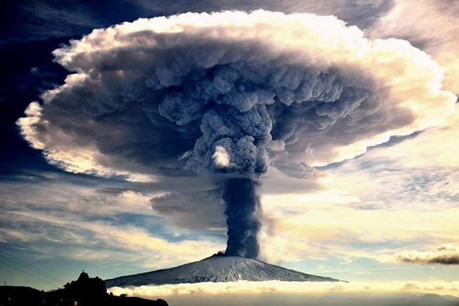
A big fire produces strong upward moving air currents that carry water vapour and ash upward. The water vapour can condense on the ash forming cloud drops. The vigorous upward motions produce these pyrocumulus clouds that look similar to thunderstorm clouds, which also form due to strong upward moving air. Cumulus clouds are those puffy-white clouds with tops that have a cauliflower appearance. Pyrocumulus clouds are greyish or brown in colour because of the ashes and smoke of the fire. The tops of these clouds can reach as high as 30,000 feet.
Instance: A pyrocumulonimbus cloud rose up over the Orroral Valley bushfire burning to the south of Canberra, Australia, on January 31, 2020.
Bergschrund
The Bergschrund or “Schrund Line” is a term that refers to the crevasse which develops at the head of mountain or corrie glaciers immediately adjacent to the rock wall of the mountain itself. As the glacier ice gradually moves down and away from the wall, a massive plucking or sapping operation takes place, whereby the rock of the mountain is progressively torn away from the mountain wall and eventually transported by ice movement or melt-water to the moraine area. Lewis has stressed both the roles of meltwater and pressure release in the bergschrund.
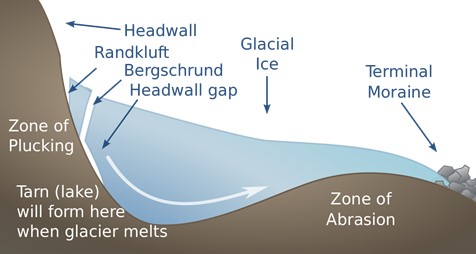
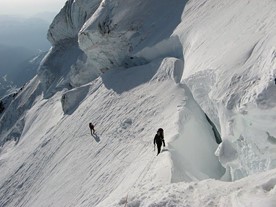
A rock and ice avalanche caused the devastation in and around Chamoli district in Uttarakhand in February,2021 which was due to a crack near the bergschrund.
Environmentalism
According to O’Riordan, “environmentalism is a collage of values and views of the world, a general pattern of predisposition, being first and foremost social movement, based on philosophy that embraces Earth- centeredness”.
There are 2 perspectives on environmentalism. The 1st is conservative view of society – nature relationship, where nature provides a metaphor for morality & a guide to rules of conduct. The 2nd perspective is radical, in which the spirit of competition in skill dictates the terms of ethics & conduct.
The recent perception of environmentalism is focused on belief that human well- being is possible only if nature is accorded its right-full place as a friendly partner in the process of development and growth and built upon deep faith that survival of humankind is dependent on the survival of a healthy and ecologically balanced environment. It attempts a greater sensitivity and awareness about the “environment” and is very close to current concept of sustainable development.
Social Capital
- Social capital is defined by the OECD as “networks together with shared norms, values and understandings that facilitate co-operation within or among groups”.
- Varieties of social capital
- There’s much debate over the various forms that social capital takes, but one fairly straightforward approach divides it into three main categories:-
-
- Bonds: Links to people based on a sense of common identity (“people like us”) – such as family, close friends and people who share our culture or ethnicity.
- Bridges: Links that stretch beyond a shared sense of identity, for example to distant friends, colleagues and associates.
- Linkages: Links to people or groups further up or lower down the social ladder
- Social capital provides the glue which facilitates co-operation, exchange and innovation.”
- Human capital and social capital don’t exist in isolation from each other.
- The two are linked in complex ways but at some extent, feed into each other. In other words social capital promotes the development of human capital and vice-versa, although the mechanics of the process are complex.
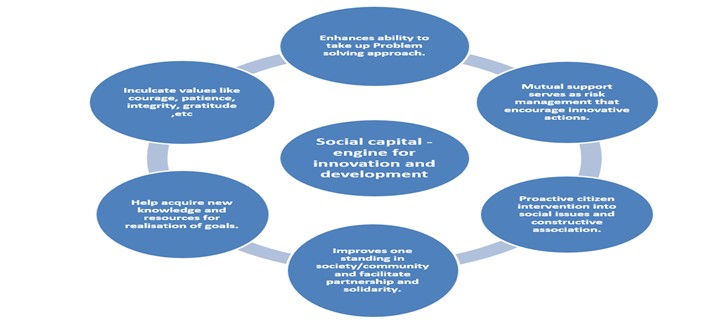
Bioremediation
- Bioremediation is the use of living microorganisms (bacteria or fungi or plants) to degrade the environmental contaminants into less toxic forms.
- The toxic compounds are metabolized by the enzymes present in the microorganism thereby turning them into less toxic forms.
- When the detoxification of waste is done at the original site of the contamination is called as In-situ Bioremediation, if it’s done away from the original site is called as Ex-situ Bioremediation.
- Cases where bioremediation is commonly seen is oil spills (was used in Alaska during Exxon Valdez oil spill, soils contaminated with acidic mining drainage, waste water treatment, and ground water contamination.
- Advantages: Cost effective, sustainable practice, produce harmless by products, can be performed at any site without causing much disturbance to normal activities.
- Limitations: Can be performed only on bio degradable compounds, tedious process, tough to perform on large scale.
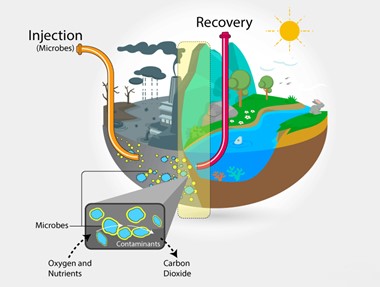
http://www.fao.org/3/a1083e/a1083e.pdfhttp://www.fao.org/3/a1083e/a1083e.pdf: Brazil
What are ICLZT Systems in Agriculture?
- Integrated Crop – Livestock systems are a form of sustainable intensification of agriculture that rely on livestock integration into cropping system with strict policy of zero tillage.
- These include growing cash crops with forage crops for grazing, including small grains and hay crops for livestock feed under Conservation Agriculture.
What is Conservation Agriculture?
According to FAO “Conservation Agriculture is a farming system that promotes minimum soil disturbance (i.e. no tillage), maintenance of a permanent soil cover, and diversification of plant species”.
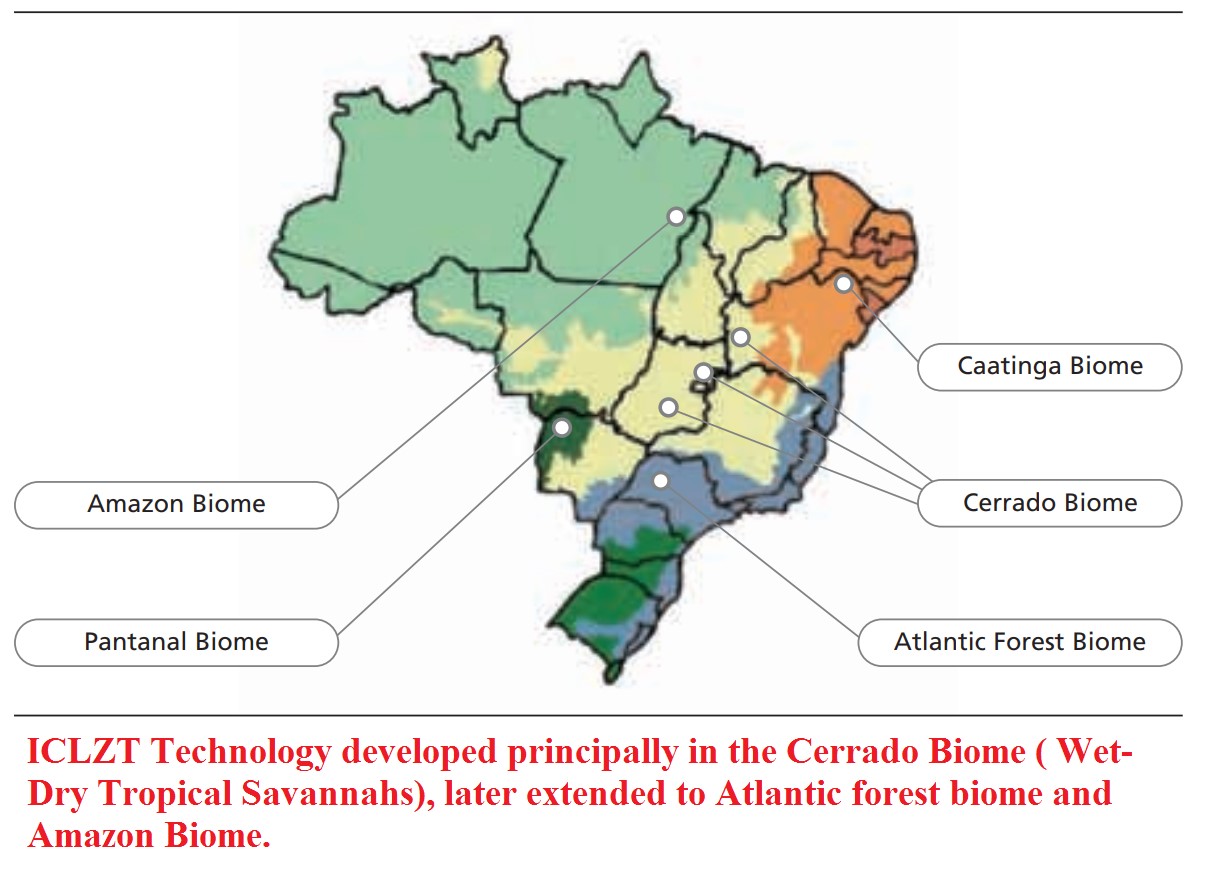
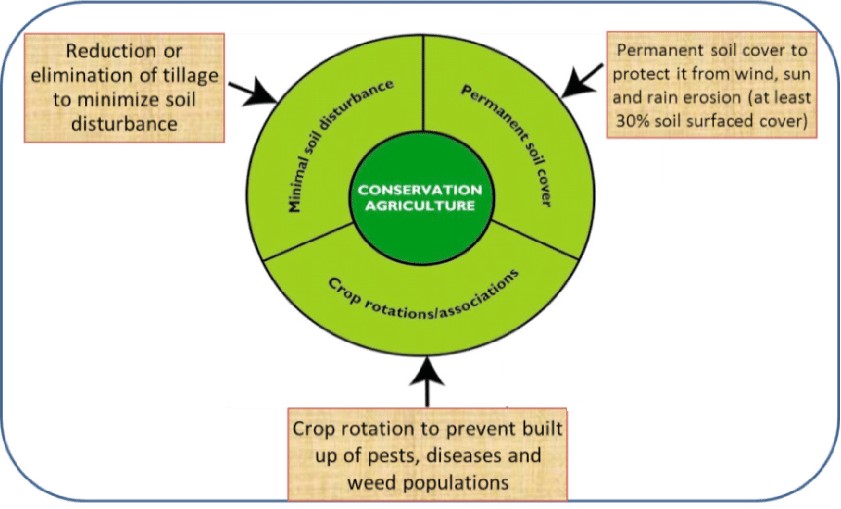
Challenges faced by Brazil:
- Soil infertility due to over grazing of cattle.
- Rapid erosion losses of up to 20 tonnes of top soil / year due to conventional tillage mainly with disc harrows.
- Cattle expansion has pushed for more forest clearing in the amazon biome.
- Soil erosion caused not only nutrient deprivation and degradation of land, but also led to environmental problems such as flooding, water siltation and pollution.
How ICLZT Systems have helped Brazil?
- Allowed sustainable production of High yield pasture without further deforestation.
- Increased profits through reduced production costs (because, no separate investment on livestock feed).
- Grazing livestock helped converting both pastures and crop residues into cash there by generating additional income for farmers.
- Improved Biological and Physical quality of soil.
- Reduction in environmental pollution through soil erosion control.
- Generation of incremental employment in agro-industry.
This ICLZT system in Conservation agriculture can be replicated in parts of Africa, South and Southeast Asia whose agro-ecological conditions are similar to those of Brazil.
Where it can be used?
This case study can be used in topics related to Paper 1 (Soil Erosion, Degradation and Conservation, Environmental Pollution, Sustainable Development, World agriculture, Food Security, Deforestation) & Paper 2 (Agriculture: Cropping Pattern, Agricultural Land Use, Crop Combination, Live Stock, Agricultural Productivity).
Tags: UPSC, Geography, Optional, Case Study, Conservation Agriculture, Brazil, Integrated crop livestock systems.
References:
The Longship Project by Norway
Why in News: The Norwegian government’s “Longship” project is set to mark the world’s first implementation of a full-scale carbon capture and storage (CCS) programme in
Norway by 2024 with a capacity of up to 1.5 million tonnes of CO2 per year. It is also in line with Norway’s climate ambitions under Paris agreement.
What is CCS?
Carbon Capture and Storage (CCS) Is the process of capturing emitted carbon dioxide (CO2), transporting it to a storage site, and depositing it where it will not enter the atmosphere.
Norway’s Plan of Action:
- Project Longship includes capturing CO2 from industrial sources in the Oslo-fjord region and shipping liquid CO2 from these industrial capture sites to an onshore terminal on the Norwegian west coast.
- From there, the liquefied CO2 will be transported by pipeline to an offshore storage location subsea in the North Sea, for permanent storage.

Potential Benefits of the project:
- Decarbonisation: It will help eliminate CO2 from the atmosphere thereby supporting our fight against global warming.
- Carbon Storage as a Service: Under this project, Norway wants to develop carbon storage as a service for whole Europe which will contribute to the development of its economy.
- Enhanced Oil recovery: The stored CO2 is often injected into an oil field as an enhanced oil recovery technique.
- Reduce the Social Cost of Carbon: The social cost of carbon is the marginal cost of the impacts caused by emitting one extra tonne of CO2. Examples could be damage from hurricanes and adverse effects on human health.
- Generate additional power: CO2-based steam cycles, during which CO2 is pressurized into a supercritical fluid, could transfer heat more readily and take less energy to compress steam, helping power generation turbines run more efficiently.
Other countrie’s initiatives:
- Saga, a city in Japan, installed a carbon capture and utilisation (CCU) plant under the city's biomass energy utilisation project.
- Canada’s Boundary Dam is the commercial scale combustion carbon capture and storage (CCS) project on a coal-fired power plant.
Where this Case Study can be used?
This case study can be used in topic related to GS 3 (Global Warming, Climate Change), Optional Paper 1 (Environmental Degradation, Sustainable Development, and Regional Development), and Optional Paper 2 (Regional Development and Planning, Climate Change, Energy Crisis).
Tags: UPSC, Geography, Optional, Case Study, Carbon capture and storage, Norway, Longship Project, Global warming.
References:
Integrated Crop-Livestock Zero Tillage (ICLZT) Systems in Conservation Agriculture: Brazil
What are ICLZT Systems in Agriculture?
- Integrated Crop – Livestock systems are a form of sustainable intensification of agriculture that rely on livestock integration into cropping system with strict policy of zero tillage.
- These include growing cash crops with forage crops for grazing, including small grains and hay crops for livestock feed under Conservation Agriculture.
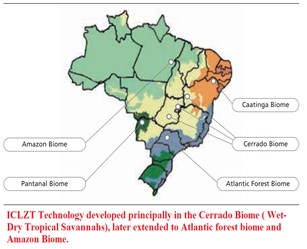
What is Conservation Agriculture?
According to FAO “Conservation Agriculture is a farming system that promotes minimum soil disturbance (i.e. no tillage), maintenance of a permanent soil cover, and diversification of plant species”.
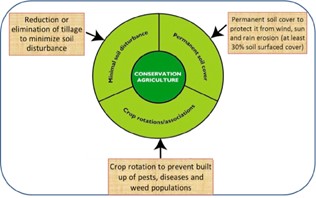
Challenges faced by Brazil:
- Soil infertility due to over grazing of cattle.
- Rapid erosion losses of up to 20 tonnes of top soil / year due to conventional tillage mainly with disc harrows.
- Cattle expansion has pushed for more forest clearing in the amazon biome.
- Soil erosion caused not only nutrient deprivation and degradation of land, but also led to environmental problems such as flooding, water siltation and pollution.
How ICLZT Systems have helped Brazil?
- Allowed sustainable production of High yield pasture without further deforestation.
- Increased profits through reduced production costs (because, no separate investment on livestock feed).
- Grazing livestock helped converting both pastures and crop residues into cash there by generating additional income for farmers.
- Improved Biological and Physical quality of soil.
- Reduction in environmental pollution through soil erosion control.
- Generation of incremental employment in agro-industry.
This ICLZT system in Conservation agriculture can be replicated in parts of Africa, South and Southeast Asia whose agro-ecological conditions are similar to those of Brazil.
Where it can be used?
This case study can be used in topics related to Paper 1 (Soil Erosion, Degradation and Conservation, Environmental Pollution, Sustainable Development, World agriculture, Food Security, Deforestation) & Paper 2 (Agriculture: Cropping Pattern, Agricultural Land Use, Crop Combination, Live Stock, Agricultural Productivity).
The Longship Project by Norway
Why in News: The Norwegian government’s “Longship” project is set to mark the world’s first implementation of a full-scale carbon capture and storage (CCS) programme in Norway by 2024 with a capacity of up to 1.5 million tonnes of CO2 per year. It is also in line with Norway’s climate ambitions under Paris agreement.
What is CCS?
Carbon Capture and Storage (CCS) Is the process of capturing emitted carbon dioxide (CO2), transporting it to a storage site, and depositing it where it will not enter the atmosphere.
Norway’s Plan of Action:
- Project Longship includes capturing CO2 from industrial sources in the Oslo-fjord region and shipping liquid CO2 from these industrial capture sites to an onshore terminal on the Norwegian west coast.
- From there, the liquefied CO2 will be transported by pipeline to an offshore storage location subsea in the North Sea, for permanent storage.
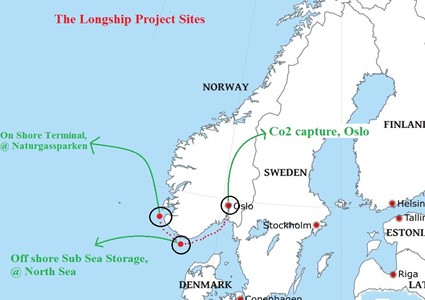
Potential Benefits of the project:
- Decarbonisation: It will help eliminate CO2 from the atmosphere thereby supporting our fight against global warming.
- Carbon Storage as a Service: Under this project, Norway wants to develop carbon storage as a service for whole Europe which will contribute to the development of its economy.
- Enhanced Oil recovery: The stored CO2 is often injected into an oil field as an enhanced oil recovery technique.
- Reduce the Social Cost of Carbon: The social cost of carbon is the marginal cost of the impacts caused by emitting one extra tonne of CO2. Examples could be damage from hurricanes and adverse effects on human health.
- Generate additional power: CO2-based steam cycles, during which CO2 is pressurized into a supercritical fluid, could transfer heat more readily and take less energy to compress steam, helping power generation turbines run more efficiently.
Other countrie’s initiatives:
- Saga, a city in Japan, installed a carbon capture and utilisation (CCU) plant under the city's biomass energy utilisation project.
- Canada’s Boundary Dam is the commercial scale combustion carbon capture and storage (CCS) project on a coal-fired power plant.
Where this Case Study can be used?
This case study can be used in topic related to GS 3 ( Global Warming, Climate Change ), Optional Paper 1 (Environmental Degradation, Sustainable Development, Regional Development), Optional Paper 2 ( Regional Development and Planning, Climate Change, Energy Crisis).
Places in news
|
1) Bhitarkanika National Park: · Why in News: Officials on June 17, 2021 launched a massive demolition drive against the illegal prawn farms in Odisha’s Bhitarkanika National Park. · It is situated in northeast Kendrapara district in Odisha in eastern India. · Inundated by the rivers Brahmani, Baitarani, Dhamra, Pathsala. · It hosts the second largest mangrove ecosystem in India after Sundarbans. · It is a designated Ramsar site. · It is home to saltwater crocodile, Indian python, king cobra and many other species of flora and fauna. |
|
2) Ramagundam: · Why in News: The biggest floating solar power plant of India is to be set up at Ramagundam in Telangana. · Ramagundam is a city in Peddapalli district of the Indian state of Telanagana. · It is located on the banks of Godavari River. · Experiences dry inland climate. Summers are extremely hot with maximum temperatures up to 47⁰ C. · Gets most of its rainfall from the South West Monsoon. · Situated in the Godavari valley coalfields and has one of the India's largest thermal power stations. |
|
3) Little Andaman: · Why in News: Turtle researchers have banded together to launch a signature campaign against the NITI Aayog’s plans to develop Little Andaman. · It is the fourth largest of the Andaman Islands of India, lying at the southern end of the archipelago. · It has uniform equatorial climate with annual average rainfall exceeding 200 cm. · Vegetation here includes Coastal mangrove forests, evergreen and deciduous tropical and subtropical moist broadleaf forests. · Shompen and Onge Tribes found here. · It provides nesting sites for leatherback turtles, listed as Critically Endangered on the IUCN's Red List. |
|
4) Gadchiroli: · Why in News: Tribal villages in Gadchiroli shown how community rights over forests could change fortunes of India’s poorest communities. · Gadchiroli is a district in Maharashtra. · It has a tropical wet-and-dry climate (savanna, Aw) with dry conditions prevailing for most of the year. · Gadchiroli is known for its tropical moist deciduous forests and is surrounded by teakwood forest. · Wainganga is the main river here which is part of the Godavari system. · Gond, Madia, Pardhan and Kolam tribes found here. |
|
5) Periyar Tiger Reserve - · Why in news: The Periyar Tiger Reserve (PTR) has launched a drive to eradicate African catfish in Periyar Lake, especially in its tributaries. · It is located in the districts of Idukki and Pathanamthitta in Kerala, in the Cardamom Hills and Pandalam Hills of the south Western Ghats. · It is notable as an elephant reserve and a tiger reserve. · Mannans, Paliyans, Malayarayans, Mala Pandarams, Uralis and Ulladans tribes found here. · The reserve is made up of tropical evergreen and moist deciduous forests, grasslands, strands of eucalyptus, and lake and river ecosystems. |
|
6) Bhopal: · Why in News: According to a new report, “There have been no improvements in process safety regulations across India even as the country is set to mark 40 years of the 1984 Bhopal Gas Tragedy in three years”. · It is the capital city of the Indian state of Madhya Pradesh, central India. · Situated in the fertile plain of the Malwa Plateau, the city lies just north of the Vindhya Range · It has a humid subtropical climate, with cool, dry winters, a hot summer and a humid monsoon season. · Kolar dam built on Kolar River provides 75 % of filtered water to Bhopal city and provides for irrigation and inland fisheries. · It is also known as the city of lakes. |
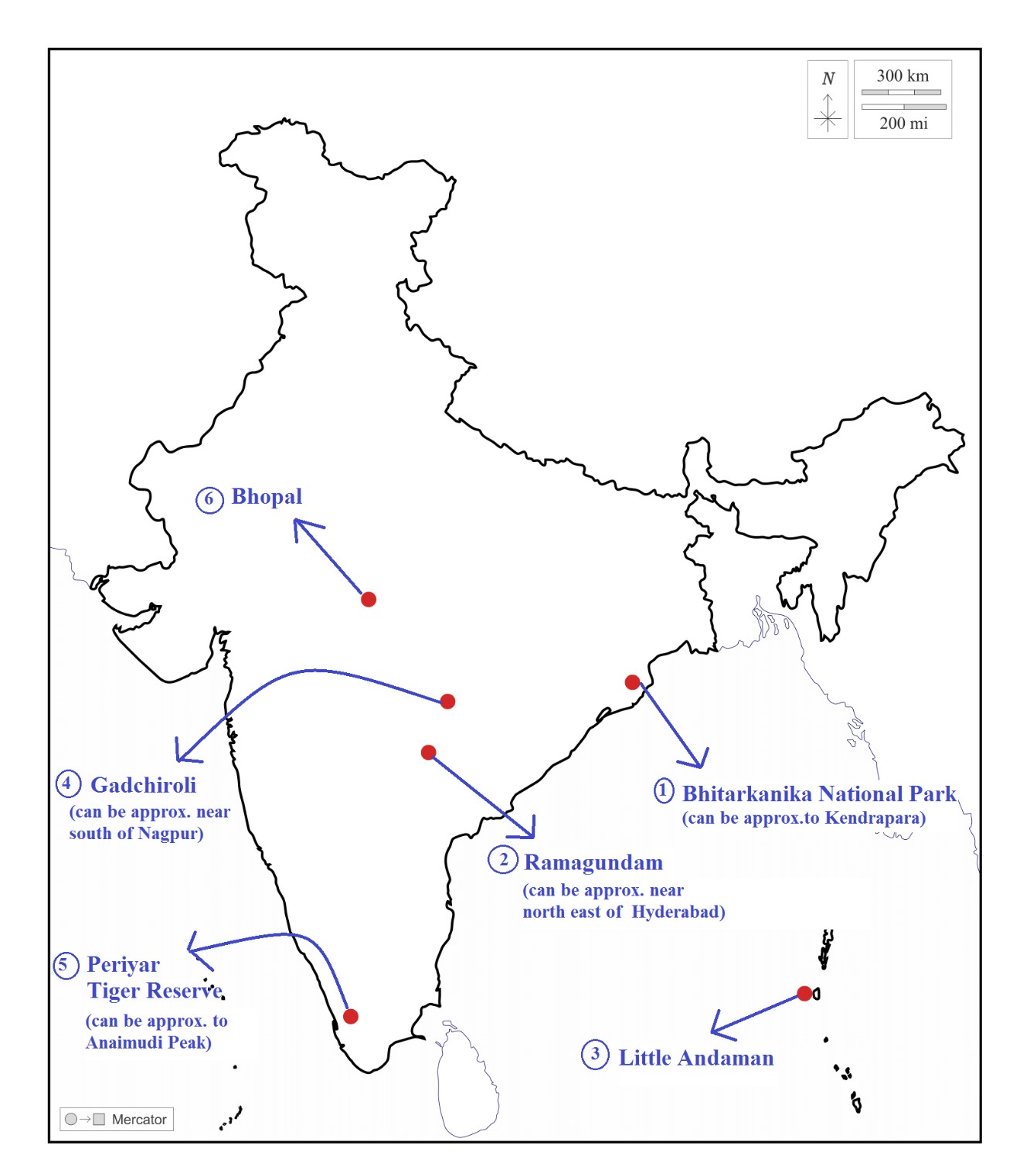
Places in news
|
Bhitarkanika National Park
|
|
Ramagundam
|
|
Little Andaman
|
|
Gadchiroli
|
|
Periyar Tiger Reserve
|
|
Bhopal
|
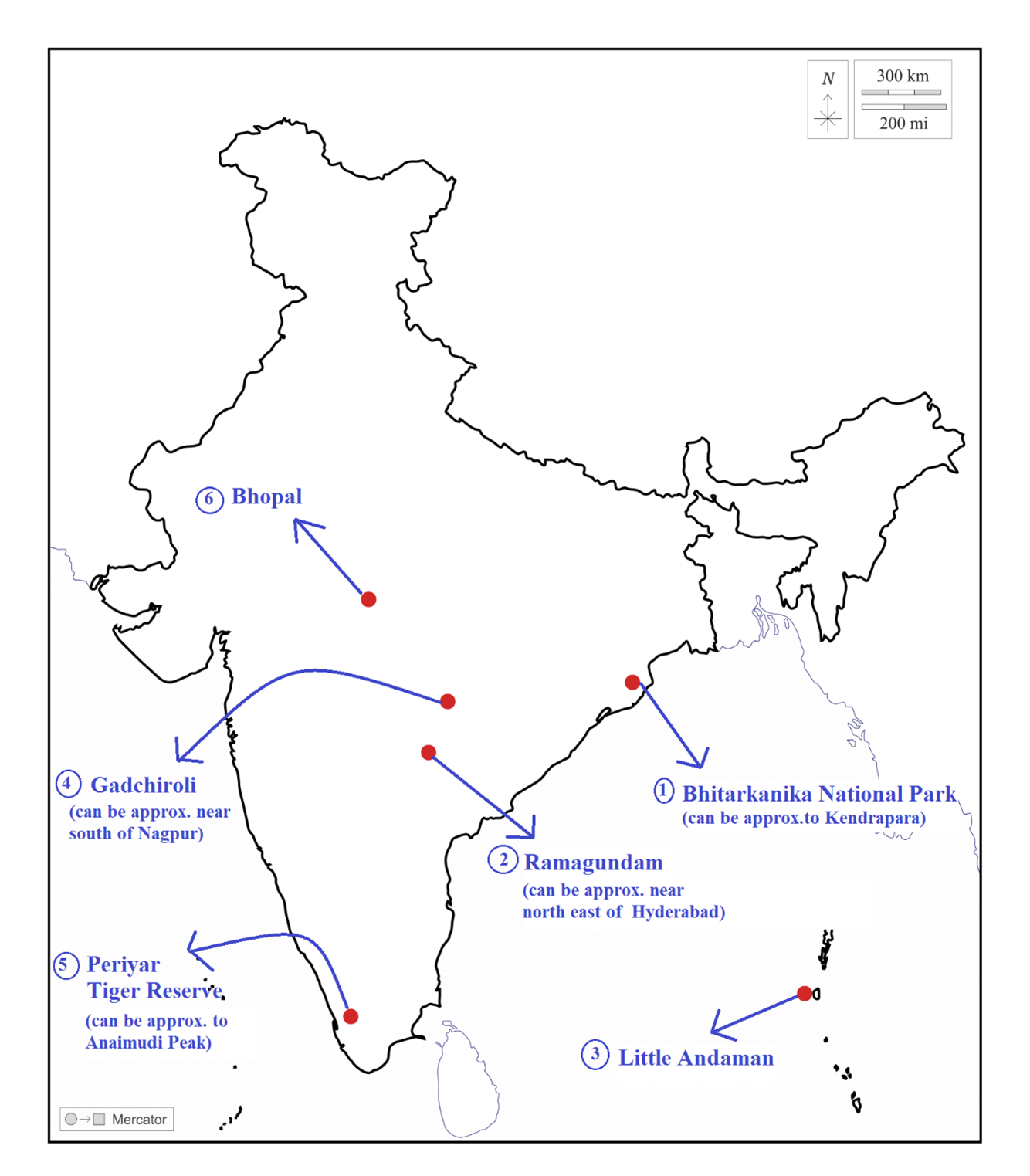
Share the article
Get Latest Updates on Offers, Event dates, and free Mentorship sessions.

Get in touch with our Expert Academic Counsellors 👋
FAQs
Geography Current Affairs focuses on the contemporary issues, events, and developments in the field of geography. It covers recent geographical phenomena, environmental changes, geopolitical shifts, and related news. This differs from regular geography studies which may focus more on foundational concepts, historical contexts, and theoretical frameworks.
Updates are provided regularly to ensure that subscribers stay informed about the latest developments in geography. Typically, updates are provided on a fortnightly basis, depending on the frequency of significant events and changes in the field.
Absolutely. Geography Current Affairs serves as a valuable resource not only for Geography optional but also for GS papers, especially GS Paper 1 (covering Indian Heritage and Culture, History, and Geography of the World and Society) and GS Paper 3 (covering Technology, Economic Development, Biodiversity, Environment, Security, and Disaster Management). It aids in building a holistic understanding of various topics and strengthens answer-writing skills by incorporating contemporary examples and perspectives.
Geography Current Affairs holds immense importance for UPSC preparation, particularly for aspirants opting for Geography optional. It helps candidates stay updated with the latest developments, geographical phenomena, environmental issues, and geopolitical shifts worldwide, aligning them with the dynamic nature of the subject as tested in the UPSC examinations.

